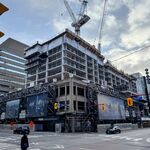In terms of the ONR, as you should be aware, no stations are "being rebuilt". All station stops will be new kiosks, existing operating buildings (GO, North Bay, Englehart) or the new build in Timmins. A quick assessment of each station stop site is in the business case. Many existing structures are no longer owned by the railways and businesses will do what businesses do.
When I say rebuilt,I meant they are building a new facility in almost the same location as where one existed.
In terms of restaurants, I wonder how many VIA corridor stations - which see multiple trains per day - house restaurants. I don't know anything about running a restaurant but being in a train station, in and of itself, doesn't sound like a great business model. There has to be other factors to keep traffic coming in the door.
Sadly, most Via stations are poorly located. Most of them are located in a sea of parking lots or somewhere in a rural area, or in an area not really that accessible.
Of the Corridor stations I have seen:
Ottawa: not really accessible till the LRT opened. Still in a sea of parking lots.
Kingston: a sea of parking lots. Not really walkable.
Brockville: In a rural setting
Windsor: In an industrial area.
St Mary's: Not really accessible.
London is downtown, so it could also house a restaurant.
Union and Central are both great examples.
For Canadian:
Waterfront: When I was there it had an A&W.
Pacific Central: In the middle of a park. There are restaurants around it.
Jasper: In the downtown of the town.
Edmonton: Middle of nothing surrounded by industrial.
Winnipeg: Located downtown. Never went in, so no idea inside.
Capreol: Located in their downtown, but nothing is open when the train goes west..
Sudbury: Located downtown, but nothing located in it.
Sudbury Junction: Middle of an industrial area.
Parry Sound: We all know what they are.
Ocean:
Mirimachi: Located in a residential area.
Halifax: Located downtown. This could house a nice restaurant.
Northlander:
Gravenhurst: located in a built up area.
Huntsville: Not really that accessible.
North Bay: Enclosed tunnel under the tracks, but not a covered walkway to the mall.
Temagami: Located right by some businesses.
New Liskeard: Not that accessible, and hidden from view.
Engelhart: Located near residential. Engelhart is smallenough that you could walk around the whole town in a reasonable amount of time.
Future Timmins: Located at the edge of some residential If space allowed, this could serve the local community.




